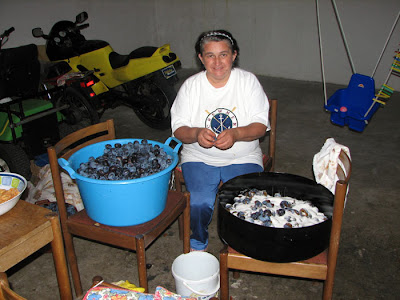I only spent a day at Lake Plitvice (pictures in the post below) and part of two other days in Croatia, as I had been there 35 years ago. There is a huge difference between Croatia and Slovenia. The latter was not involved in the war that resulted in the break up of Yugoslavia, hence they did not waste money on it. Croatia did and is definitely not as wealthy, yet the cost of living appears to be just as high as in Slovenia. In fact riding a bus cost much more. And there is plenty of garbage strewn about.
Slovenia is in the European Union and of the 8 countries that joined in 2004, it had the highest per capita income. Croatia is currently negotiating to join. From what I have been told in France, when the Euro came into effect there, the price of everything shot up (yes, France is definitely expensive, as is any country that has the Euro), so I can't imagine the hardship in Croatia if it adopts the Euro.
Euopean toilets are generally much more interesting than those in North America. Sometimes I couldn't find the flusher, but like magic, it flushed when I opened the door. The set-up above was common. Can you guess what the two circles indicate?
The bus station in Zagreb had some likeness to an airport. This huge egg was one of two that decorated the area I waited in. There was also a display case with Croatian wines, and a bottle of Slivovitza, which is made from the rotten prunes that I mentioned in the email.
This was my accomodation near Lake Plitvice Park, called House Katica Bicanic. I helped this lady with her chores, such as digging potatoes and pitting prunes. Her husband was away, as he is a professional bowler, but he did get home late in the evening and drove me to the entrance to the park the next morning. Staying here was a wonderful experience!
Here we are, pitting prunes, which were to be made into jam. We have already done as many as we could in the really big bucket. Once we got down to the rotten layer they were left to be made into Slivovitza (see instructions on how to make here, but I don't see in those instructions that you can use prunes with mold on them!). The white on the prunes on the right is sugar, not mold.
She used the jam (though it wasn't very sweet) for filling for strudel, which she sells at the entrance to Lake Plitvice Park (where she claims she is the #1 seller). Unfortunately I didn't get to sample any, as she was not making any for a few days.
Slivovitza is often made at home and is the national drink of the Balkans. Although other fruits are occasionally used, the finest slivovitz is made from completely ripe prunes.
As I was told here, "Slivovitza then coffee." Its alcohol content often exceeds 51 percent (102 proof), and believe me, it tasted like it did!
I was offered a couple of these. Nice beer. In the background is Lake Plitvice National Park. This part of Croatia gets a meter of snow in the winter, yet further inland, in Zagreb, they rarely see snow.
The bus station in Zadar, on the coast of Croatia. There were 33 platforms! Generally, the poorer the country, the more frequent the buses. Great for people who don't want to rent a car.
The friendly climate on the coast of the Adriatic allowed for a long growing season. This house used its front yard to grow as many vegies as they possibly could.
The outside of this store in the old part of Zadar was done, but they were working on the inside. I have no idea what it is to become.
The most unusual door I have ever seen.













very good posting. i liked it. :-)
ReplyDeletebathmate